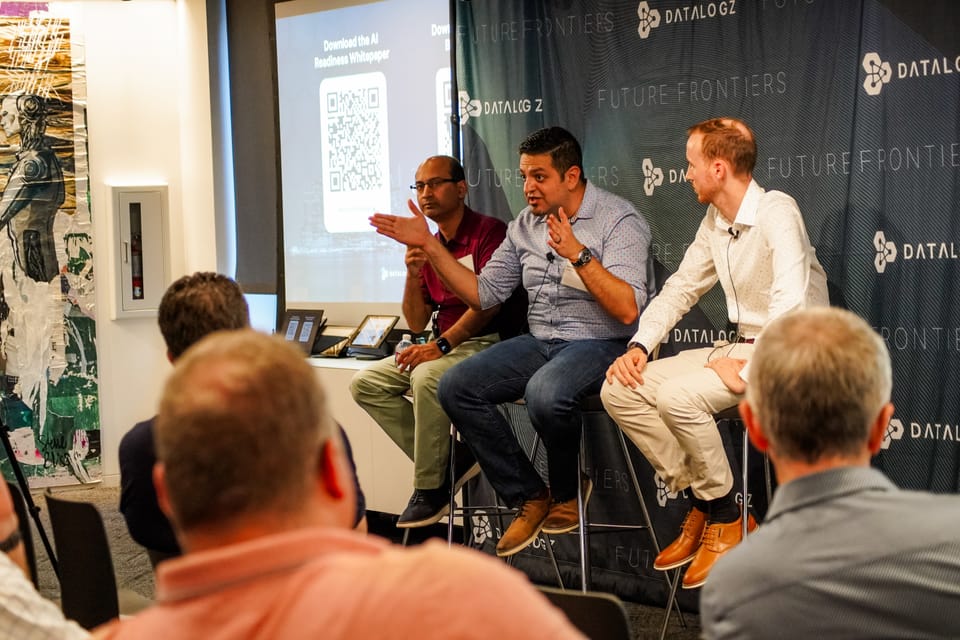Using Data to Improve the Federal Government, and Tackle America’s Biggest Challenges
The people carrying out public service work on some of the most fascinating challenges, and aim to make a big impact. Yet, like all enterprises, the federal government can benefit from increased use of data to bring together disparate environments, improve efficiency, and access innovation.

Across the federal government, data is being used to solve hard problems that help to protect and defend America, while improving life for the nation’s citizens.
The people carrying out public service work on some of the most fascinating challenges, and aim to make a big impact. Yet, like all enterprises, the federal government can benefit from increased use of data to bring together disparate environments, improve efficiency, and access innovation.
To explore how the federal government is working to improve systems, processes, and culture Datalogz recently hosted a conversation with data leaders at the forefront of federal data adoption. Held in New York, the latest event in Datalogz’ Future Frontiers series featured DJ Patil, the former Chief Data Scientist of the United States, Kristyn Jones, former Under Secretary of the US Air Force, and Logan Havern, Co-Founder and CEO of Datalogz. The panel discussion offered an inside look at the federal government’s recent progress on data-driven initiatives, from solving BI Sprawl to introducing AI, to using data to solve massive challenges from healthcare to the military.
Here’s a look at what we learned from these influential leaders.
Data and the Mission
The event came at a time of transition in Washington. With the election of President Donald Trump, the federal government will be seeing new leadership, and potentially shifting priorities.
No matter the outcome of an election, Patil reminded data leaders that there is always work to be done, no matter which administration or party that won the most recent election. Patil has a long track record as an influential force in data, having helped to coin the term “data scientist. Drawing on a background that took him from the DoD to top private sector tech companies such as LinkedIn, RelateIQ (acquired by Salesforce), eBay, and PayPal, Patil served as Chief Data Scientist in the White House under President Barack Obama. But a change of administration didn’t signal an end to the work. He went on to work with the Trump administration in areas such as organ donation reform, and the opening of hospital data to the public.
Military members take a “mission first” approach to government service. Patil said that applies to all work in the public sector.
“What I would just encourage everyone to think about at the end of the day is, what's the mission?” Patil said. “The mission, fundamentally, is to use these technologies to better serve the American public, and to serve our long-term interests. That can be corporate interests, that can be nonprofit interests, that can be academic interests. Those interests are what is the most important to focus on. Everything else is noise, in my opinion.”
The government has an enormous portfolio of policy areas where it works to improve life for Americans, and there are plenty of challenges to work on. Data is likely to play a key role in many of the priorities identified. Drawing on a deep background in leadership of the Air Force, Jones identified increasing efficiency and autonomy as two areas that are of particular interest.
“Data is the new oil,” Jones said. “That's particularly true in a military sense where the pace of change is fast, and the pace of operations is going to be very fast.”
With an emphasis on creating more efficiency in government operations, federal agencies will need to draw on data to understand what is working, and show return on investment.
More use of data also opens up the potential to share data with partners and allies, enabling all parties to gain a richer understanding of the operating environment, and make decisions.
Inside the Air Force’s business systems, the work of modernization is ongoing. A particular effort was focused on pulling together data from across the service’s vast enterprise, and putting it to work to inform better decisionmaking, and ultimately show the breadth of the Air Force’s operations. This presents opportunities to improve, and also provides greater transparency to the American people. A unified data environment that demonstrates proper governance and access controls can improve auditability.
Data is also playing a greater role in the military’s work to advance America’s national security. China’s military is rapidly modernizing. Space is an increasingly contested domain. Cybersecurity continues to be an area of concern as the threat landscape evolves.
Data underlies America’s approach to addressing each of these challenges, and innovative tools are assisting in maintaining the competitive edge that is necessary.
The ROI on Public Service
For a leader that is looking to implement these new technologies, it is equally necessary to measure the impact. There is financial ROI that is measured for the business, and ROI that comes from adding military operational capability.
“In many cases, the ROI is your impact on mission and risk,” Jones said.
At the same time, many government efforts have long time horizons. During Patil’s tenure in the White House, President Obama launched an initiative to deliver truly genomic medicine. It involved collecting the largest repository of data ever collected about humans at the genomic level, and applying it to enrich understanding of diseases, tailored treatments, and progress them faster. The project continues today, and has carried on through multiple presidential terms.
The Cancer Moonshot was also launched under President Obama with the ambitious goal of ending cancer. The tactical steps to work on this effort required what has now become 15 years of efforts to change policy and lay the groundwork for artificial intelligence to be harnessed in these efforts.
This underscores the unique role of government. Initiatives that will bring lasting change to society can’t be measured in the business timeline of a quarterly, or even the lifespan of a four-year presidential term. But leaders made a bet that it will pay off in the future.
“So we often look at it as, ‘Well, what have you done for me lately?’ Rather than, what is the long arc of all that has gone into place to allow this moment to take place and unlock potentially trillions of dollars of value, as well as impact our healthcare?” Patil said.
This underscores the unique role of government in driving innovation. It can identify massive societal challenges and seed research and development to take them on. It takes a mix of patience and urgency, one eye on the mission, and another on creating a new market. Ultimately, the government and the private sector must work together.
“People forget — where's that spark that turned into a fire like AI, the internet, genomic research, decoding the human genome? That is done by government,” Patil said. “Investors, startups — that starts to nurture the flame. People come in with their careers — that makes the flame brighter. People come up with new innovation. That's how we get this engine working. That's a ‘we’ effort to make this take place.”
At times, the goals are strategic just as much as they are societal. In the military, Patil said that setting a goal to create the first AI-native fighting force will help America achieve dominance. Part of that achievement will lie in the second and third-order societal impacts of achieving that goal.
“If you have AI dominance, you can discover new materials, you can figure out how to engineer, that means you solve a lot of powerful problems, and you can get faster,” he said. “You can do better at all the other things that are kinetic, but you can also solve so many other problems on the medical side. That is why you're hearing so much about the artificial intelligence aspect of these problems now, and what's required to support artificial intelligence? Today, if you don't have the data, you don't have AI.”
Ending BI Sprawl in the U.S. Government
For all of the advances that are taking place, data leaders still have to strike a balance. Massive enterprises such as the federal government rely on legacy systems, even as they introduce the latest technologies.
That was true in the Department of Defense, where there were a number of legacy tools.
“Their environment in some cases is the definition of BI sprawl,” Jones said.
BI Sprawl describes the many issues that result from too many BI tools operating in silos. When there is a lack of coordination between BI tools and guardrails around the environment, reports can be incorrect, redundant, or simply not used. This lack of controls leads to a lack of consistency that results in mistrust in data, wasted compute that drives up cost, and could result in improper access that increases security and compliance risk.
“This problem is so frustrating to me, and I've dealt with this problem so many times in different organizations,” Patil said. “It's something I'm very passionate about, because I'm just sick of spending money just going to the data warehouse, going to CPUs, and the data warehouse getting slower and slower and slower because I've got all these dashboards that are getting unused and they're just like orphaned children. It's where data goes to die slow, painful deaths.”
To solve BI Sprawl, it’s necessary to bring data from disparate BI tools together, establish centralized governance around data use and access, and implement monitoring to identify and solve issues that arise.
“The ability to really understand across a massive enterprise where your data is at, who's using it, being able to see anomalies — I think it is really important for the federal government to do that cleanup.” Once the environment is clean and reliable, she said, then the organization can implement, the right data governance and data management to support AI.” What’s more, “I think going right to the AI misses some of the fundamental steps that need to happen, at least in the agencies that I was working with.”
While much of the conversation in enterprise technology is currently coalescing around adoption of AI, BI and AI don’t have to be mutually exclusive. In fact, they are two parts of an array of layers that operate as one data ecosystem. In particular, BI lies at the consumption layer, where the majority of users business access data. When analyzed in aggregate, it’s an important proving ground to determine the effectiveness of data tools, and win trust in the data. For data leaders, there’s an opportunity to leverage the excitement around generative AI to create a more reliable environment.
“One of the beautiful things about AI right now is it's a forcing function to get your data shop in order,” Patil said. “Financially, that's why you need Datalogz to control that, otherwise you're going to get crushed on pricing, on your data layers, you don't have manageability.”
Increasing reliability can also help to increase trust in the data that is being used.
“Think of the framework of trust as consistency over time,” Patil said. “And so if a data product fails you one time, it's hard to get that trust back. And so you want to evolve your data products on a strategy of keeping and retaining and growing that trust.”
With a clean and reliable environment, a business will be set up to quickly implement the latest advances in AI, at the time when they are at the cutting edge.
Data-Driven Culture, from the Bottom to the Top
Alongside a clean and reliable data environment, implementing data-driven culture is equally important in creating a high-performing data-driven enterprise, especially at a large organization such as the federal government.
"If you're making decisions on a $215 billion budget without it being data enabled, without having the right information on, on tradeoffs and risk, then you're spending a lot of time, and resources, potentially, ineffectively.”
Data must be embedded in processes. But culture means that it must also be embedded in people. In her leadership role at the U.S. Air Force and U.S. Space Force, Jones oversaw a department of nearly 700,000 people.
“Getting everybody all on the same page is a challenge. I think the tone from the top is really important,” Jones said.
A variety of tools and tactics are required. For Air Force Secretary Frank Kendall, one tool was a sign over an office door displaying a famous quote that is attributed to the mathematician W. Edwards Deming.
“In God we trust; all others must bring data.”
“For any meeting that anybody had with Secretary Kendall, you knew that you had to have the right story from a data perspective,” Jones said.
In meetings, Jones carried out that tone by asking questions, and asking for data that backed up a point. The more she asked, the more people knew they had to bring data to assess operational impact and risk, as well. The result can be a “trickle-down” effect. The overall goal was to focus less on rewarding work to friends and new, shiny things, and more on evaluating risk and operational impact.
“In order to do that, you have to have the right data available. You have to have the right business systems that provide that data and make sure that it's accurate,” Jones said. “You needed to have all the right tools and then people needed to know how to use them.”
When folks have the right tools, they must be enabled to use them. The Air Force offered training on analytics and visualization through a program called Digital University.
Along with top-down, a bottom-up approach is also necessary. Inside the White House, Patil and a group of technology leaders implemented strategies to nurture ideas that came from across the federal government.
On weekly calls, anyone from the team could show Patil a data project, and he would evaluate it. If he liked it, the person’s manager was on the call to validate that the idea would receive support.
The approach served to inspire collaboration. As others in the federal government saw ideas receiving a thumbs-up from the Chief Data Scientist, they started asking how to apply the approaches showcased in meetings in their own departments.
“And so you went from a few people, to a few dozen people, to hundreds of people, to thousands of people,” Patil said. “And then suddenly now you have a team that are aligned. You have shared language, you have shared stories. You have a common mission together. And so now you have an organic system across this organization to make things happen.”
It’s that ecosystem that ultimately drives more innovation, Patil said.
“We have an ecosystem. We can collaborate,” Patil said. “The more you share, the more you work, the more you have a collective approach. That's how you create that groundswell movement so that we can then figure out how we meet the moment to take on these challenges across organizations, from small to very big.”
Get Involved Today
There’s a lot of good that comes from using data to serve the public. The best way to access the opportunity to do it is to join government service. To close out the session, the panelists were asked their advice to anyone considering opting in to the government.
Jones admitted that the salaries aren’t as high as the public sector, but that didn’t deter her from returning to the federal government.
“The reason that so many of us serve and that why it's sometimes hard to let it go, is that sense of purpose. You are working on the world's most impactful problems, whether it's our national security, our health, the ability to make sure that our food is safe, our education.”
Government service doesn’t only have to happen in a massive enterprise of the federal government. It can happen at the local or state level, or on a project that responds to a particular need.
“It's always an awesome time to jump in. There's so many problems out there, there's so many vehicles you can do it,” Patil said. “Just jump in and find a way in. Be relentless. And then once you're on the inside, just remember you're not alone. You just have to raise your hand and you'd be amazed at the number of people who will show up to support you.”



